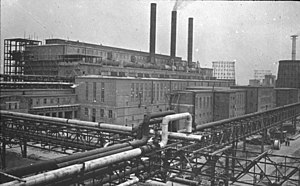
Back معسكر اعتقال مونوفيتس Arabic Аушвиц III Моновиц Bulgarian Camp de concentració de Monowitz Catalan Auschwitz III – Monowitz Czech KZ Auschwitz III Monowitz German Auschwitz Monowitz Spanish Monowitz Finnish Monowitz-Buna French Campo de concentración de Monowitz Galician אושוויץ מונוביץ HE
| Monowitz Buna-Werke | |
|---|---|
| Concentration camp | |
 IG Farben factory in Auschwitz III-Monowitz | |
Monowitz in occupied Poland | |
| Coordinates | 50°02′07.8″N 19°16′40.8″E / 50.035500°N 19.278000°E |
| Other names | Monowitz (placename) |
| Known for | Forced labor camp |
| Location | Near Oświęcim, Polish areas annexed by Nazi Germany |
| Built by | IG Farben |
| Operated by | Schutzstaffel |
| Commandant | Heinrich Schwarz |
| Original use | Factories for producing synthetic rubber and chemicals including Zyklon B |
| First built | October 1942 |
| Operational | October 1942 – January 1945 |
| Inmates | Mainly Jews |
| Number of inmates | Around 12,000 |
| Killed | 2,500 |
| Liberated by | Red Army on 27 January 1945[1] |
| Notable inmates | Primo Levi, Victor Perez, Elie Wiesel, Fritz Löhner-Beda |
Monowitz (also known as Monowitz-Buna, Buna and Auschwitz III) was a Nazi concentration camp and labor camp (Arbeitslager) run by Nazi Germany in occupied Poland from 1942–1945, during World War II and the Holocaust.[2] For most of its existence, Monowitz was a subcamp of the Auschwitz concentration camp; from November 1943 it and other Nazi subcamps in the area were jointly known as "Auschwitz III-subcamps" (KL Auschwitz III-Aussenlager). In November 1944 the Germans renamed it Monowitz concentration camp,[3] after the village of Monowice (German: Monowitz) where it was built, in the annexed portion of Poland. SS Hauptsturmführer (Captain) Heinrich Schwarz was commandant from November 1943 to January 1945.
The SS established the camp in October 1942 at the behest of IG Farben executives to provide slave labor for their Buna Werke (Buna Works) industrial complex. The name Buna was derived from the butadiene-based synthetic rubber and the chemical symbol for sodium (Na), a process of synthetic rubber production developed in Germany. Other German industrial enterprises built factories with their own subcamps, such as Siemens-Schuckert's Bobrek subcamp, close to Monowitz, to profit from the use of slave labor. The German armaments manufacturer Krupp, headed by SS member Alfried Krupp, also built their own manufacturing facilities near Monowitz.[4]
Monowitz held around 12,000 prisoners, the great majority of whom were Jews, in addition to non-Jewish criminals and political prisoners. The SS charged IG Farben three Reichsmarks (RM) per day for unskilled workers, four (RM) per hour for skilled workers, and one and one-half (RM) for children. The camp contained an "Arbeitsausbildungslager" (labor education camp) for non-Jewish prisoners viewed as not up to par with German work standards. The life expectancy of Jewish workers at Buna Werke was three to four months; for those working in the outlying mines, only one month. Those deemed unfit for work were gassed at Auschwitz II-Birkenau.[5][6][7]
Primo Levi, author of If This Is a Man (1947), survived Monowitz, as did Elie Wiesel, author of the Pulitzer Prize–winning book Night (1960), who was a teenage inmate there along with his father.
- ^ "Timeline for I.G. Farben and the Buna/Monowitz Concentration Camp". Wollheim Memorial. Retrieved 11 December 2012.
- ^ "Auschwitz III-Monowitz". Auschwitz-Birkenau Memorial and Museum.
- ^ Cite error: The named reference
Lasik2000p151was invoked but never defined (see the help page). - ^ Synthetic Rubber: A Project That Had to Succeed (Contributions in Economics and Economic History) by Vernon Herbert & Attilio Bisio.Publisher: Greenwood Press (11 December 1985) Language: English ISBN 0313246343 ISBN 978-0313246340
- ^ Anatomy of the Auschwitz death camp by Yisrael Gutman, Michael Berenbaum. Indiana University Press (1998). ISBN 025320884X, ISBN 978-0253208842.
- ^ Night by Elie Wiesel. Bantam (1 March 1982). ISBN 0553272535, ISBN 978-0553272536.
- ^ The Nazi Doctors: Medical Killing and the Psychology of Genocide by Robert Jay Lifton. Basic Books (August 2000). ISBN 0465049052, ISBN 978-0465049059.
© MMXXIII Rich X Search. We shall prevail. All rights reserved. Rich X Search
